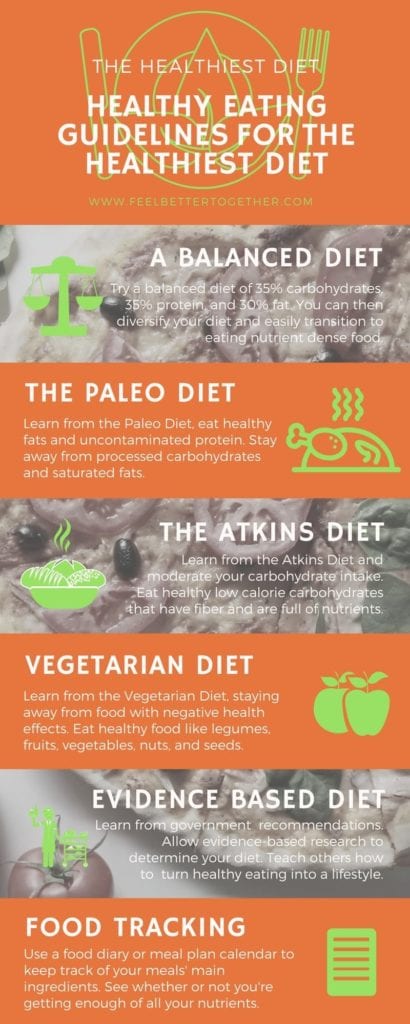Are you having trouble picking a diet plan? There are many diets, and some are the same, with different names. Everyone these days is dieting in one way or another, depending on their food preferences. All this makes it hard to decide which one will get you the results you want.
It’s even harder to figure out which one is the healthiest diet for you in particular. The exciting news is there are several diets already laid out that will teach you how to eat healthily and not starve.
Don’t wait until you need to go on a diet plan for medical reasons. Take action before that happens so you can eat healthy based on preference. Otherwise, you’re stuck with the diet your doctor gives you. You’re about to find out about some of the most popular diet plans.
Five Quick Tips to Help You Eat Healthy and Not Starve
- Try a balanced diet of 35% carbohydrates, 35% protein, and 30% fat, which will allow you to diversify your diet and include many nutrient-dense foods.
- Learn from the Paleo Diet and make sure you eat healthy fats and uncontaminated protein, all the while avoiding processed foods.
- Learn from the Atkins Diet and moderate your carbohydrate intake. Eat healthy low-calorie carbohydrates that have fiber and are full of nutrients.
- Learn from the Vegetarian Diet and exclude food that has adverse health consequences. Eat nutrient-rich food like legumes, fruits, and vegetables. Not forgetting to include plenty of nuts and seeds.
- Learn from government recommendations and use evidence-based information to determine your diet. Set an example of proper nutrition and teach others by turning healthy eating into a lifestyle. Show others how to make healthy food choices.
BONUS TIP! Use a food diary or meal plan calendar to keep track of the main ingredients for each meal. After about a week take a look and you’ll get a good idea of whether you are getting enough of all your nutrients.

Good Nutrition – A Balanced Diet
Let’s cover real quick what dieting is not. If you are serious about burning fat, you’re most likely in a calorie deficit. Doing this is not dieting; it’s burning fat, and anyone trying to avoid serious health problems knows that you need to consume enough micronutrients.

I’m talking about vitamins, minerals, lipids, and amino acids. Getting the right amounts of these is the real trick that many of us are yet to master.
It’s All About Percentages
Diet plans are about percentages, and a balanced diet is no exception. Paying attention to macronutrients is what dieting is all about. It’s helpful to know your maximum calories, but you can diet without it.
Either way, dieting means you will pay attention to your carbohydrates, protein, and fat.
For most people, a balanced includes 35% calories from carbohydrates, 35% protein, and 30% fat. These numbers can vary for you, especially in the area of carbohydrates.
Your body may break down carbohydrates at a different rate than others. Or you may have diabetes and need to track or limit your carbohydrate intake.
These percentages are a great starting place for anyone. There is a certain amount of trial and error when it comes to a personalized balanced diet.
It’s a good thing your body can adapt to various shortages of food. The goal here is to find a balance between the different macronutrients. You benefit the most from getting proper amounts of all three of them.
The Benefits of Balance
The 35, 35, 30 rule also works well if you are dieting for the first time. If you have been on a diet low in any macronutrient, this diet will have you feeling pretty amazing after a few days.
I’m talking more energy and a better regulated hunger sensation.
A balanced diet may improve your health so much because you’re not going too far in any one direction. You’re not limiting anyone macronutrient, and you’re getting all your nutrients.
Good nutrition helps your body regulate itself. A balanced diet is the best diet to go on if you are not sure what to eat on a diet. Or if you want to include food that you already enjoy in a nutrient-rich diet.
Healthy Protein Diet – The Paleo Diet
The Paleo Diet has received a lot of attention. People using it have seen fantastic health benefits.

The healthy food choices associated with it are like those of the Paleolithic period, which is why it’s called The Paleo Diet.
Paleo Restrictions
There is a restricted food list for the paleo diet. These foods include some starchy carbohydrates. Examples are potatoes and grains. Legumes like beans are a restricted food as well.
You’re not allowed to eat the most processed foods on this diet. Such food includes low nutrient carbohydrates and food high in saturated and trans fat.
The restriction of salt is another thing that makes this diet stand out. A lot of food has sodium in it already. Moderating sodium intake increases your body’s ability to fight infections.
Some people also see the paleo diet as a low carbohydrate diet, because the carbohydrates you can have are low in calories and high in fiber. You can have carbs, only certain kinds though.
Paleo Health Benefits
In general, the paleo diet promotes food that is high uncontaminated protein. Fibrous carbohydrates and polyunsaturated fats are also high on the list.
Many Foods high in nutrients appear here. These include grass-fed meat, seafood, healthy oils, as well as nuts and seeds.
The healthy fats, especially omega-3 fatty acids, are very beneficial for brain health. Not to mention keeping your cholesterol in check.
The one nutrient that does not show up often in the paleo diet is calcium. I recommend a calcium supplement if you are on or considering the Paleo Diet.
The increase in protein and fiber intake, in particular, promote health. Both fiber and protein combined have a massive effect on controlling hunger.
Controlling hunger and feeling fuller go hand in hand, making this diet a winner for weight loss.
This one-two punch of nutrient-rich food and unhealthy food restriction makes this a great diet plan, especially when you are in a calorie deficit and trying to burn fat.
Or, maybe you are maintaining your weight, and need a good reason to get into a nutrient-rich diet. This diet might be for you.
Using Fat for Energy – Low Carb / High Fat Diet
Low carbohydrates diets have had success in reducing seizures since the early 1900’s. Doctors were able to reduce the frequency and intensity of epileptic seizures.

There have been many variations of low carb dieting since then. The majority of them are still used to treat various medical conditions.
One fantastic benefit of these diets is their tendency to starve cancer cells. Cancer cells don’t use fat for energy well and carbohydrates are their primary energy source.
Your brain and muscles use glucose from carbohydrates as their primary fuel source. In the absence of carbs, your liver produces ketones.
Ketones are an alternate fuel source for your brain. Your body enters what’s called ketosis when you begin to create more ketones.
At first, this can cause some other uncomfortable symptoms. Your body may take a week or so before it adapts. But, your body adjusts to using fats and ketone bodies as it’s primary fuel sources.
Let’s take a closer look at what’s it’s like to be on a couple of these diets.
Ketogenic Diet
The first documented high-fat diet started out as an experimental medical treatment. Doctors were trying to control epileptic seizures with diet restrictions. The first thing you figure out on the traditional ketogenic diet is calories from fat.
Your goal here is for 75-80% of your daily calories to come from fat. You then add in 1 gram of protein for every kilogram of body weight. The number of calories left over after all that can come from carbohydrates each day.
Doctors tell patients to fast the first day of keto. Fasting helps you come into the diet with lower blood sugar levels. Low blood sugar means low glycogen, and this is when your body adjusts to using fat as a primary fuel source. During this time you may have low energy levels and a sensitive stomach.
Atkins Diet
When you start out on the Atkins diet, your first step is limiting carbohydrates. You’re asked to take a close look at how many grams of carbohydrates are in each of the foods you eat. Net carbs are what you’re counting here, and 12-15 grams is what’s allowed per day at the beginning of phase 1.
To count net carbs, you consider the total carbohydrate count in food and subtract the fiber. Unlike other carbohydrates, fibrous carbs are broken down in your colon or pass with your waste. Other sugars, your body stores as fat if not used. Those are net carbs.
If you have more than 15 pounds to lose, the Atkins Diet suggests you start at phase 1. Eat a few extra carbs each day for two weeks until you reach 20 grams per day.
You’re going to need to do some meal planning, but you will need less and less as you progress through the phases. Phase two then starts at 25 grams per day and can go up to 80 grams per day, and is where you should then stay until the next step of the diet.
You enter this step when you are within 10 pounds of your weight loss goal. Phase 3 is where you add 5-10 grams per day each day until you reach a weight loss plateau.
When the weight loss stops, you have entered phase 4. You then maintain your weight by eating the same amount of carbs each day on average.
Specific nutrient deficiencies are the most significant drawback of the extreme low carbohydrate diets. The biggest problem with restricting fruit and vegetables is getting vitamins and minerals.
I’m talking B Vitamins, Vitamin D, and electrolytes. You can still get all of these if you are focused on good nutrition.
Water and electrolytes are essential in a low carb diet, such as sodium, chloride, magnesium, potassium, phosphorus, and calcium.
Not enough calcium is a big problem. If you ignore these essential nutrients, it will become necessary that you supplement.
Your food portions on low carbohydrate diets are also smaller because they are higher in fat. 1 gram of fat contains more energy (calories) than 1 gram of protein or carbohydrates.
If you have been abusing sugars, then you may want to consider one of these low carb diets. They can help you lose weight and avoid type 2 diabetes.
What do Vegetarians Eat? – The Vegetarian Diet
There are many reasons someone may go on a vegetarian diet. These diets can be full of micronutrients. To eat healthily, you need a nutrient-rich diet.

On the other side of things, there is food that we avoid. What does the vegetarian diet exclude? What you restrict on a vegetarian diet comes down to preference. Let’s talk a little more about the different kinds of vegetarian diets.
What to Exclude on the Vegetarian Diet
A typical vegetarian diet excludes meat, fish, poultry, dairy, and eggs. Allowing some of these food categories is what creates the different vegetarian diets.
The main variations differ in whether they allow eggs, milk, fish, and even chicken. These are all sources of complete protein. Protein plays a big part in maintaining energy levels and the body’s healing process. That’s why protein supplements help build muscle.
Getting enough protein is a struggle for new dieters on the vegetarian diet, and you may need to plan on incorporating protein-rich food into your diet.
A vegetarian diet that allows fish, chicken, or eggs will be good for getting enough protein. However, this is not a typical vegetarian diet.
Great Vegetarian Sources of Complete Protein
- Soy
- Quinoa
- Beans and Rice
- Pita Bread and Hummus
Another word of warning if you’re new to dieting. Getting too many carbohydrates on a vegetarian diet is easy. Fruit, vegetables, and grains may be in most if not all your meals.
Abusing carbohydrates will lead to a problem with weight gain and type 2 diabetes. Avoid refined sugars especially if you can help it. You can replace these with nutrient-rich fibrous carbohydrates and healthy fats.
Healthy fats, especially omega-three fatty acids can sometimes get left out. Included nuts and seeds, or otherwise supplement to get your omega 3’s.
A vegetarian diet requires a little bit more effort and meal planning. But, with a plan, you can get the most out of a vegetarian diet.
Government Food Recommendations – Evidence-Based Diet
Every five years the USDA and HHS publish nutritional guidelines for the general public. A law passed in 1990 that requires the U.S. Department of Agriculture and Health and Human Services to do this.

The Office of Disease Prevention and Health Promotion (ODPHP) is also helpful. You should know about the practical and healthy recommendations that they have published.
They formed in 1976 and are an excellent resource for information and actionable guidance. Their content focuses on healthy eating as a lifestyle. There is also an emphasis on the community where everyone gets involved.
The USDA Center for Nutrition Policy and Promotion (CNPP) hosts “Choose My Plate.” The organization, and Choose My Plate website, have information if you are new to dieting. All these agencies mention physical activity and exercise for good health.
The guidelines state that 71% of people in the U.S. eat more than the recommended amount of saturated fat per day. They say you should limit this as well as trans to less than 10% of your daily calorie intake.
Cheese and meat are the primary contributors to saturated fat intake. Not only cheese but all dairy products should be fat-free or low fat.
Recommended Carbohydrates
Added sugar is one of the biggest bad guys in these guidelines. They suggest you limit these to no more than 10% of your daily calorie intake.
You will find added sugar in many processed foods. The guidelines also state that you should limit refined grains. They should be no more than 50% of your total grain intake.
Recommended Protein
The guidelines mention excellent sources of protein. You need all the essential amino acids for proper nutrition. They suggest lean meat with low amounts of saturated fats.
Sources of complete protein include legumes, lean meat, and poultry. Also eggs, fish, nuts, seeds, and soy.
Keep in mind that these USDA and HHS guidelines are for the general public. You may need to adjust your macronutrient balance if you are trying to burn extra body fat.
You would be better off replacing the grains or fruit with protein or fibrous carbs. You can also substitute dairy with nuts, seeds, and unsaturated oils as long as you keep your calcium and vitamin D up.
If you follow all the advice put forth by these guidelines you will be in an excellent place nutrient wise. Except for the part about added sugars and refined grains.
You’re better off leaving those out or avoiding them as much as possible. Most of them have little to no micronutrients, and your body needs nutrients, that why we get hungry.
In Conclusion
Most of the diets mentioned in this article address a lack or abuse of specific nutrients. Food choices confront us on a daily basis.
You can now face your daily diet choices with confidence. Choose the food you eat, before your doctor tells you to, because at that point it may be too late.
It’s time to pay attention to having a diverse diet with many different kinds of food. All whole, unprocessed food is beneficial in a particular way.
People have lived off of whatever was available from the land for thousands of years. From insects to fungus, it all has nutrients. There is a lot more variety accessible to most of us than ever before.
You can eat healthily and be on a diet that you enjoy no matter who you are.

